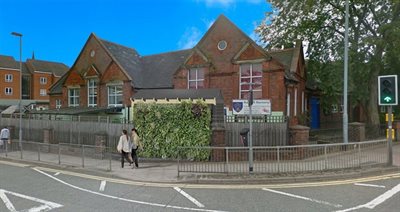Posted on Tuesday 18th May 2021

An image of the living wall in Newcastle
Living walls – natural filters made from plants and mosses which help to reduce air pollution – are being installed in two Staffordshire locations as part of a national clean air trial.
Staffordshire County Council and its transport partner Amey have secured the expertise of two industry leaders as part of the Live Labs SIMULATE programme, which is designed to not only test mobility hubs but to trial new innovations that can improve air quality across Staffordshire.
The county council is looking to improve air quality by removing harmful pollutants from the air or by reducing the amount of emitted from transport using the road network. This involves removing or reducing particulates of nitrous oxide and nitrogen dioxide.
It is working with two companies, Biotecture and 40two to install a series of living walls in Staffordshire. Biotecture will trial an Active Green Wall (AAU) along the barrier wall of the early years playground at Hassell Community Primary School in Newcastle-Under-Lyme and with 40two to trial a living moss wall in Burton-on-Trent on a boundary fence at the junction of Shobnall Road and Wellington Street.
Julia Jessel, Staffordshire County Council’s cabinet member for environment, infrastructure and climate change said:
The installation of living walls in Newcastle and Burton is another exciting development in our ADEPT Smart Places Live Labs programme. They should help to reduce air pollutants through natural filtration which is great news for local communities. We look forward to receiving the results of the trial and potentially rolling this out to other locations.”
The trial with Biotecture will provide a live demonstration of the AAU technology, providing the teams with evidence of air pollutant removal and the benefits to those living in close proximity to the plant-based walls. Plants remove pollutants through their leaves and roots.
The aim is to use the AAU technology to direct cleansed air into clean air zones that provide relief from pollution. The AAU will remove pollution and expel this into a shelter which can provide a clean air zone. Without this shelter the air that has been cleansed will be dissipated into the atmosphere and is unlikely to provide a noticeable benefit to ambient air. For the purposes of this trial, a clean air shelter will be installed.
Richard Sabin, managing director at Biotecture said:
Using biological filtration to actively clean our polluted air is a hugely exciting area of research that we’re delighted to be championing with our partners. Harnessing the power of plants with technology to improve air quality in both indoor and outdoor spaces has significant potential implications for public health, and we look forward to sharing results later in the year."
Live Labs programme director, Giles Perkins said:
The Live Labs ethos is built around innovation, not just on our local highways but around them. This initiative links places-based improvements to roads improvements and illustrates what should be in the wider basket of environmental technologies to improve the places we live, learn, work and play.”
Paul Rose, technical director at Amey Consulting said:
Plants have the unique ability, to remove pollutants through the process phytoremediation. Using plants in areas such as buildings and public spaces adjacent to main roads, train stations and construction sites, it’s hoped that a noticeable difference can be made to the quality of air in these challenging locations.”
The trial with 40two Technology will look at a variety of moss and lichen that are capable of capturing CO2, NO2, and fine particulate matter from the air, while releasing oxygen. The moss wall consists of a vertical structure, which filters air passing through and around it, with vertical surfaces covered in appropriate moss and cryptogamic plants. By placing it between the accommodation and the road, the pilot will be able to demonstrate the reduction in airborne pollutants (NO2, CO2 and particulates) from the air around the living accommodation.
Simon Young, co-founder of 40two, explained:
We’re really excited to be part of the Live Labs SIMULATE programme, and get to trial our moss wall in an area that has such a problem with poor air quality. Moss and other cryptogamic plants have been recognised as having carbon capturing qualities for some time, so it made sense to look to nature to address man-made problems. By measuring just how much of a difference our moss wall can make to air quality, we’re expecting to learn a lot about how to make this kind of natural solution available anywhere it’s needed.”
Whilst these trials get underway, air quality sensors will continue to monitor air quality across Staffordshire. With lockdown easing and more people expected to return to the roads, understanding road network usage and the impacts this has on air quality will be fundamental for the teams to then recommend mitigating and pollutant reduction solutions to improve air quality.
The £22.9m Department for Transport-funded programme is run with the Association of Directors of Environment, Economy, Planning and Transport (ADEPT).